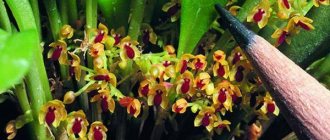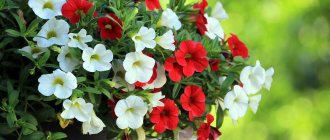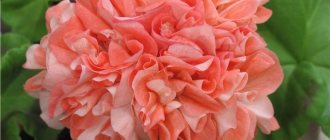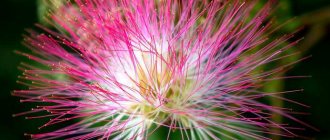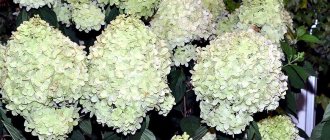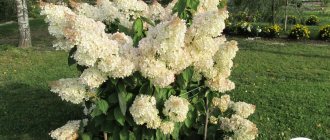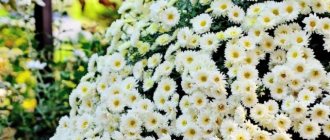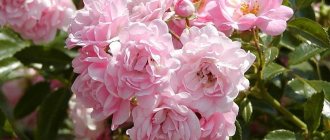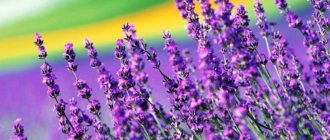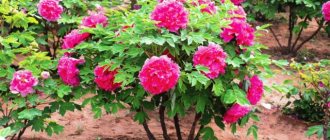This is a collection of still rare petunias that reproduce vegetatively. Petunia Crazitunia is an ampelous variety; it differs from all other ampelous varieties in its early flowering, elevated growth, and greater flowering density. This series of petunias is characterized by high resistance to weather and temperature conditions.
Looks beautiful in flower pots and hanging boxes. The seed pods that remain after flowering are empty, so they do not produce seeds, which means they reproduce by cuttings. Those varieties that produce seed very rarely retain their maternal characteristics and properties. For care, they require one pinching, rarely two, but otherwise they only need watering, fertilizing, and plenty of lighting.
Starry sky
Petunia Night Sky
Several new hybrids have very interesting colors, reminiscent of a starry sky. The German ampelous variety of petunia Night Sky, which received the FleuroStar Award in 2015, is distinguished by a unique spotted flower pattern; white spots are chaotically scattered on a blue-lavender background, as if the artist had splashed paint from his brush. This variety is accompanied by Bonnie Mystery Sky with very small bright spots on a dark blue background.
Czech hybrids of the Dot Star F1 series have a similar coloration. They are available in two versions - deep pink - Deep Pink and purple color - Dark Violet.
Petunia Dot Star Deep Pink F1
The pattern of each flower with a diameter of 6-7 cm is individual; the shape and number of spots change depending on weather conditions. The height of the plants is 30-35 cm, they branch well, bloom profusely and for a long time, perfect for a flower bed, flowerpot, hanging basket or balcony box. The creators of the hybrids claim that the plants quickly restore their appearance after heavy rains and abundant watering.
Ampelous and cascading petunia
Varieties and hybrids with flexible and long stems, 80–100 cm, flowers 4–9 cm in diameter. Used as a hanging form for a flower pot or as a ground cover plant for open ground.
Surfinia F1 (Surfinia) , Suntory, Japan. The first ampelous series of heterotic hybrids to appear. The series includes varieties that form lush cascades of cascading shoots, strewn with flowers of various colors, with a diameter of 5.5–9 cm. Classic varieties of surfinia are early flowering plants, with powerful and long stems, characterized by high growth vigor. • Patio Blue – color changes over time from purple to blue. • Hot Red – red petals with dark veins and throat. • Peppy Neon – deep purple with dark veins and neck. • Pink Morn – bright pink with a light neckline. • Red – bright red flowers are quite large, the bush shape is compact. • Deep Red is a bronze winner of the American Garden Award in 2012 and other awards in the field of floriculture. Deep red color. • Sweet Pleasure White Lila Eye Patio F1 – white petals with a dark purple throat. • Blue Vein - flowers with dark blue, almost inky, veins and throat. The fragrant aroma intensifies in the evening.
Surfinias of the Table series have less branching and are distinguished by more compact, dense bushes. The flowers of many varieties of Table have an unusual shape: elongated, resembling bells. • Table White is one of the most spectacular surfinias. Small snow-white flowers look like bells and densely cover the entire bush. • Table Salmon Vein is a small-flowered surfinia, covered in “salmon” flowers in season.
The Double series of surfinias includes ampelous plants with large, densely double flowers. In terms of the abundance of flowering, they are slightly inferior to the classic varieties, but at the same time they look unusually decorative. • Double White – white in color. Branches along the entire length of the shoots. • Double Purple – purple flowers, resistant to rain. A powerful, branched plant that develops in a horizontal plane. Branches can reach 1 m, height - only 10-15 cm. • Double Red - red flowers require more careful care than other varieties of the Double series. If agricultural practices are violated, growth may be inhibited.
The Surfinia Specials series includes compact plants for patios. In particular, Surfinia F1 Amethyst is a compact plant for the patio, does not require shaping, and grows with a thick green head. The flowers are deep purple with a white throat. It has a pleasant aroma, which becomes especially strong in the evening and spreads several meters from the plant.
Tumbelina (Tumbelina) , Suntory, Japan. This variety series is attractive with medium-sized double flowers with dark veins on the petals. It also reproduces vegetatively. The most popular variety is Priscilla with pale lilac flowers decorated with purple veins.
Supertunia (Supertunia) is a variety series created by Japanese breeders of the Sakata company. In appearance, these ampelous petunias are similar to surfinias; minor differences are observed only in the technical characteristics. The flowers are large, 6–10 cm in diameter, with long shoots. The root system does not grow, so the varieties grow well in hanging pots. There are two-tone colors. • Pretty Much Picasso – light purple petals, dark throat, green edge. The variety received a prestigious award at the international exhibition IPM 2010 in Essen, Germany, in the category “Best New Balcony Plant.”
Potunia Series (Potunia) , Dummen, Germany. Plants do not need extended daylight hours to bloom. The bushes are compact, lush, retain their spherical shape well and branch. Side shoots are formed without additional pinching. The varieties are resistant to temperature changes, diseases, and rain. Do not require abundant watering. The flower size is from 5 to 10 cm in diameter. • Purple Halo – purple neck, white petals. • Papaya – orange-red color. • Cobalt Blue – entered the market in 2013 under the brand name Red Fox Potunia Cobalt Blue. The flowers are white, with a yellow-green center, large, corrugated. The shoots are dense, up to 50 cm long. • Strawberry Ice – deep pink with red veins and a dark throat. Has a pungent aroma.
Conchita (Conchita) , InnovaPlant GmbH & Co. Thanks to its small flowers, the variety series resembles a variety of petunia - calibrachoa. The color of the flowers ranges from white with a greenish throat to pale lilac and dark crimson. The flowers are small, about 5 cm in diameter, there are double varieties. Petals, pharynx and veins can be painted in different colors. In addition to varieties with simple flowers (Blossom White, Evening Glow, Summer Dawn, Blueberry Frost, Strawbeny Frost, Twilight Blue, etc.), varieties with double inflorescences of different colors are produced: Lavender, Blue, White, Pink, Velvet.
Crazytunia , Elsner. Unlike traditional ampelous petunias, the plants are short, more compact and raised by 20–40 cm. The flowers are small, about 5–6 cm in diameter. They do not require pinching, do not outgrow, bloom early, bloom long and profusely. • Black Mamba – black velvet color. • Cherry Cheescake - a large white star on a red background. • Red Blues – deep red with a dark neck.
• Twighlight Blue – light lilac with a dark neckline. • Star Jubilee – yellow star on a black background.
Chameletunia (Chameletunia) More compact compared to traditional hanging petunias. • Sunpleasure Purple Yellow Circle - a purple flower with a yellow border.
Cascadias , Danziger, Israel. The varieties branch well, do not require forming pinching, and form a hemisphere. The flowers are numerous. They withstand adverse weather conditions and bloom profusely throughout the season. • Cascadias Rim Chianti - raspberry pink petals with a narrow contrasting white border. • Cascadias Rim Violet - purple petals with a wide or narrow contrasting white border.
Selected varieties of ampelous petunias: • Viva White with Red Veins – compact, large, white flowers with red veins and neck. • Designer Pink Star – lush bushes, flowers about 7 cm in diameter, with a wavy edge. The color is pink with a white star in the center. • Success Violet, Benary, Germany – early bloomer, purple flowers. • Success Burgundy, Benary, Germany – early bloomer, wine-colored flowers. • Fanfare Lilac Shades – compact bush, large lavender flowers. • Grape Star is a compact bush that forms a hemisphere. The color is purple and white. • Ordy Painted White – pearly white color. • African Sunset F1, Takii Seed, Japan. 2014 All-America Selections winner. Announced as the first truly orange petunia grown from seed. Height 30 cm, flower diameter 6–7 cm. • Bicolor Black (Littletunia) – a miniature form of ampelous petunia. Pale yellow petals, dark ink stripes.
• Night Sky – winner of Fleurostar 2015, “The most stunning plant of the year.” “Stars”—white dots—are formed on a thick violet-blue background. The color of each flower is unique, depending on the light, temperature, and soil pH. It branches well without pinching, is suitable for hanging flowerpots, and grows up to 60–70 cm in the ground.
Solar coloring
Petunia Easy Wave F1 Yellow
Pure yellow flower color is rare in petunias; more often it is cream, and bicolor varieties with bright yellow stripes also appear. However, you can find a suitable specimen in the famous series of hybrid petunia Easy Wave F1. Hybrid Easy Wave F1 Yellow is distinguished by simple pale yellow flowers with a richer golden yellow color in the throat. If you want to add sunny shades to a flower garden or container, it is better to plant a relative of petunia - calibrachoa; it is the varieties and hybrids of this species that have the brightest yellow and orange colors.
Pirouette Rose F1 (Pirouette rose F1)
If you need petunias for balconies or small flower beds, pay attention to the hybrid petunia Pirouette rose F1. The compact bush reaches a height of only 12-15 cm, while the long side shoots that form are up to 35-45 cm. The leaves of the plant are small. They are practically invisible under the cap of dense double flowers with wavy petals, which are scattered on every bush.
The flowers are large, reaching 10-13 cm in diameter, the center of the flower is pink, and there is a white border along the wavy edge.
Rose Petunia Pirouette F1 is an early ripening rose - the first flowers appear on the bush in early May. With proper care, flowering continues until frost.
Fine mesh
Petunia Daddy Blue F1
The mesh pattern gives the flowers extraordinary sophistication; for example, the variety from the Daddy Blue F1 series has dark blue, contrasting veins visible on a lilac-blue background. This American series of hybrid petunia also has other delicate colors - Pink, Red, Sugar, Orchid, Peppermint, which combine harmoniously when planted together. The plants are distinguished by very large flowers with a diameter of 8-10 cm, they branch well; to obtain a lush bush, the shoots should be pinched. Recommended for planting in balcony boxes.
Mandevilla Loose
From May to November it blooms in white and pink. In winter it sheds its crown. The buds are collected in inflorescences of 15 pieces. The flowers are modest in size, rarely reaching 9 cm in diameter. The leaves are oval with sharp tips, the color is bright green. The underside is grey-burgundy.
The difficulty of care is average. Watering is constant - 3-4 times a week. During the period of flowering and active growth, fertilize frequently, along with watering. In winter, moisture and fertilizing are reduced. Air humidity is maintained as in the tropics - 60%.
Mandelina Superb
An evergreen climbing plant with large flowers of rich scarlet color. The inflorescences contain 6-8 flowers. Cup-shaped with a long rim. The foliage is round and shiny.
Loves fertile acidic soils. Grows up to 3 m. Blooms from May to November. The flower in the apartment is oriented towards the south, as it needs bright light. Humidity – tropics all year round, 60%.
Important! During growth, they are fed with mineral fertilizers.
Mandevilla splendid
Large pink, red or white flowers, 6 pieces per brush. The leaves are shiny, lined with veins on the underside. The shoots are smooth and flexible. Flowering is long lasting.
Mandevilla splendid
Soils required are loose and acidic. The room is oriented to the south and west sides. The plant requires several hours of direct sunlight. Needs constant watering and high humidity.
Mandevilla boliviana
Characterized by remarkable decorative qualities. Flowers are formed in leaf axils. The corollas are long, there are 3-4 flowers in one raceme. White color. The leaves are large and are not shed in the winter.
Agrotechnical measures are carried out within the requirements for tropical crops. When seedlings are purchased from nurseries, they are not immediately transplanted. They quarantine for a week so that the plant gets used to its new place of residence. At this moment you need to care for it and treat it with Fitosporin and Fitoverm.
Important! The flower endures stress after moving, so it is very vulnerable to diseases and pests. After a week of adaptation, it is transplanted.
Mandevilla is a tropical exotic. Growing it indoors is troublesome. A flower is purchased when it is possible to create conditions close to natural. The plant needs a lot of sun, moisture, and nutrients. It is susceptible to diseases and pests. Deviation from agrotechnical rules leads to the death of the plant.
Bright stripes
Bicolor petunias are not rare; breeders create varieties with white spots along the edge of the corolla or rays diverging from the center. New items amaze the imagination with unusual color combinations.
The variety from the Amore – Fiesta series is very impressive; vertical yellow and dark red stripes create a pattern in such a way that on each corolla you see five bright hearts. The purple "hearts" contrast with the yellow central star. The plant is 30 cm tall, suitable for pots and hanging baskets, weather-resistant and restores its spectacular appearance even after heavy rain.
Petunia Amore Fiesta
The Crazytunia series is unique in its colors and patterns. One of the varieties - Pulse - combines rich dark purple, cherry and yellow colors. Compact bush with a height and diameter of about 30 cm for balcony boxes, flowerpots and flower beds.
Petunia Crazytunia Pulse
The Mystical series features a fantastic two-tone color scheme. With a compact crown, the Phantom variety is an eye-catcher with a black velvet flower background with a bright yellow star-shaped center.
Petunia Mystical Phantom
In the coming season, breeders promise to release a terry version of this variety for sale.
Features of home care
Mandeville flowers require special care. Agricultural practices regarding the plant should not be violated so that the question does not arise as to why the mandevilla does not bloom.
Dipladenia ampelae or Mandevilla - home care
The following conditions must be observed:
- Temperature. In winter, the room temperature is +12-15 °C, in summer 18-26 °C. Above 26 °C is not harmful. In summer, the pot is taken out into the air, but without drafts.
- Lighting. Requires bright light, but not direct sunlight.
- Watering. Moisturize frequently and generously 2-3 times a week. On hot summer days, water twice a day. You cannot overwater the plant. The soil should dry out a few centimeters. Use settled water.
- Air humidity. Plants native to tropical forests require high air humidity. Therefore, pots are kept in trays with wet expanded clay or in special display cases. Spray twice a day.
- Priming. The soil is loose, light, hygroscopic. The acidity level is average.
- Feeding. During flowering, feed every week with complex mineral fertilizer. Combine with watering.
- Support. The liana is grown on a support. She is tied up, shaped, guided. Mandevilla is suitable for trellises and trellises. The shoots are tied with twine and sesal.
- Wintering. Home care for the mandevilla liana includes proper wintering. The pots are placed in a cool room with a temperature not lower than +12 °C. Stop spraying and water moderately.
Important! Do not overfeed mandevilla with nitrogen fertilizers. The plant will have healthy green foliage but will not bloom.
Mandevilla pruning
Splendor and aroma
Petunia Tumbelina Priscilla
The hybrid Atkins petunia Tumbelina Priscilla was created by English breeders and is quite resistant to the vicissitudes of the weather; the elastic flowers are not damaged by rain. All petals have contrasting veins, the central ones are strongly curled and form a lush flower of a delicate lilac color. The height of the plant is 30-35 cm, the shoots hang spectacularly from baskets and flowerpots. The magnificent flowers have a delicate aroma, which is rare among modern petunia varieties.
Cascadias Rim Magenta
The variety Cascadias Rim Magenta belongs to the cascade (ampelosa) types of petunias. The plant forms in large quantities and in a short time long (about 50-60 cm) strong shoots, turning into a very dense bush. In its central part, the stems are directed predominantly upward, and along the edges they deviate to the sides. To make the bush round, the plant must be properly pruned and regularly pinched.
A little mystery
Petunia Crazytunia Black Mamba. Photo by the author
The black color of flowers always attracts attention, as it is quite rare. In reality it is not pure black, but dark purple, like the Crazytunia Black Mamba.
The rich dark color goes well with any colors and sets them off. A composition in black and blue colors will look mysterious and gloomy, black and white - stylish and strict, black and red - solemn and elegant. The variety is distinguished by large velvety flowers, resistant to adverse weather conditions, a compact bush about 30 cm high, it can be planted in a flower garden, flowerpot or hanging basket.
Use the main achievement of modern petunia breeding - an extraordinary variety of colors, and your flower garden will never be boring.
Reproduction
The correct way to propagate mandevilla is by cuttings. Young, non-lignified shoots are cut in the summer. Take the apical parts. Place in peat, cover with a glass jar. The substrate is moistened. The cuttings are periodically ventilated. The cover is removed completely when it is clear that it has taken root. Transplant into a container. The procedure takes 3 months.
Pereskia flower - home care
They are rarely propagated by seeds because they are not commercially available. It is difficult to collect planting material on your own. Even if it is possible to obtain seedlings, they are grown for many years with careful care. Therefore, this method is not rational.
Important! Mandevilla does not grow in open ground in Russia because it does not tolerate frost.
